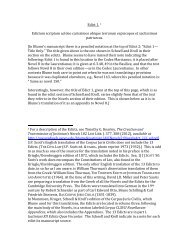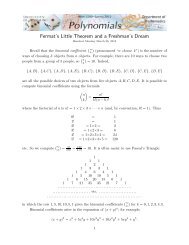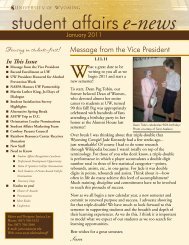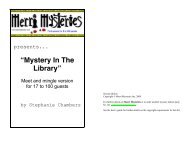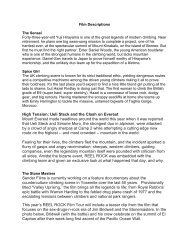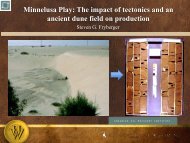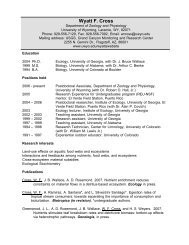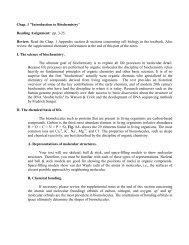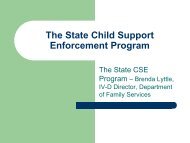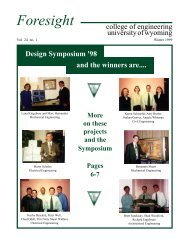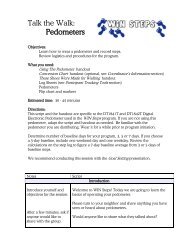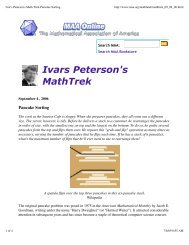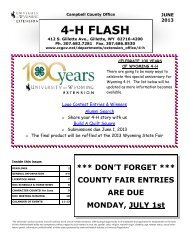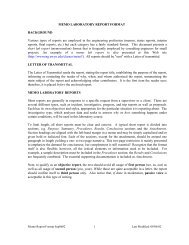microhabitat selection for nesting and brood-rearing by the greater ...
microhabitat selection for nesting and brood-rearing by the greater ...
microhabitat selection for nesting and brood-rearing by the greater ...
You also want an ePaper? Increase the reach of your titles
YUMPU automatically turns print PDFs into web optimized ePapers that Google loves.
78 CHRISTOPHER P. KIROL et al.<br />
TABLE 1. Microhabitat characteristics measured at nest sites, locations of early <strong>and</strong> late <strong>brood</strong> <strong>rearing</strong>, <strong>and</strong> r<strong>and</strong>om locations,<br />
south-central Wyoming, 2008 <strong>and</strong> 2009.<br />
Variable Description<br />
of each Daubenmire quadrat to yield 9 or 13 height measurements<br />
<strong>for</strong> each <strong>microhabitat</strong> location.<br />
EXPERIMENTAL DESIGN AND DATA ANALYSIS<br />
We employed a use-versus-availability design to evaluate<br />
fourth-order habitat <strong>selection</strong>, or <strong>selection</strong> of items from<br />
a habitat patch (e.g., a nest site; Johnson 1980, Manly et al.<br />
2002). We pooled locations individual grouse use locations<br />
to represent a population-level response (i.e., type I design of<br />
Thomas <strong>and</strong> Taylor 2006; Manly et al. 2002). R<strong>and</strong>om locations<br />
were also pooled <strong>and</strong> constrained within <strong>the</strong> boundaries<br />
of each study area (Manly et al. 2002).<br />
For statistical analyses we used SAS version 9.2 (SAS<br />
Institute 2009). We evaluated <strong>microhabitat</strong> <strong>selection</strong> with<br />
binary logistic regression modeling. For each period (<strong>nesting</strong>,<br />
early <strong>brood</strong> <strong>rearing</strong>, <strong>and</strong> late <strong>brood</strong> <strong>rearing</strong>), we determined<br />
<strong>the</strong> probability of use where used (e.g., early <strong>brood</strong>-<strong>rearing</strong><br />
locations) <strong>and</strong> available locations (e.g., r<strong>and</strong>om locations) were<br />
<strong>the</strong> dependent variables (Johnson et al. 2006). We did not define<br />
r<strong>and</strong>om locations, representing available habitat, as unused<br />
resources because <strong>the</strong> absence of a nest or <strong>brood</strong>ing female cannot<br />
be determined without error (i.e., we are not certain that <strong>the</strong><br />
r<strong>and</strong>om locations were all unused). However, we excluded r<strong>and</strong>om<br />
locations that had evidence of <strong>nesting</strong> or <strong>brood</strong> <strong>rearing</strong>, so<br />
contamination was likely negligible (Johnson et al. 2006).<br />
Prior to modeling, we computed a Pearson’s correlation<br />
matrix to test <strong>for</strong> multicollinearity among <strong>the</strong> variables<br />
(linear dependencies among <strong>the</strong> explanatory variables) <strong>and</strong><br />
omitted one of each correlated variables when correlation<br />
C<strong>and</strong>idate sets<br />
Nest Early-<strong>brood</strong> Late-<strong>brood</strong><br />
I II III I II III I II III<br />
SAGECVR Sagebrush canopy cover (%) ×<br />
SHRUBDEN Shrub density (plants m –2 ) ×<br />
VOBST Visual obstruction (horizontal cover; dm) × ×<br />
FORBS Total <strong>for</strong>b cover (%) × × ×<br />
GRSCVR Cover of perennial <strong>and</strong> residual grasses (%) ×<br />
LITTER Ground cover <strong>by</strong> litter (%) × × ×<br />
ARTRW Wyoming big sagebrush or o<strong>the</strong>r sagebrush × × ×<br />
BIOCRUST Biological soil crust (%) × × ×<br />
CHEAT Presence or absence of cheatgrass × × ×<br />
GANDR Gravel <strong>and</strong> rock cover (%) × ×<br />
PERGRS Perennial grass cover (%) × ×<br />
FOODF Food <strong>for</strong>b cover (%) × ×<br />
SAGECVR Sagebrush canopy cover (%) × ×<br />
SAGEHGHT Average sagebrush height within location (cm) × ×<br />
SHRUBDEN Shrub density (plants m –2 ) × ×<br />
GRSHGHT Averaged maximum perennial grass droop height (cm) × ×<br />
coefficients (r) were ≥|0.6|. Using a correlation matrix alone<br />
is often not sufficient because, when combined, multiple<br />
variables may be highly interdependent but not be detected<br />
<strong>by</strong> <strong>the</strong> matrix procedure (Allison 2009). Consequently, we<br />
fur<strong>the</strong>r examined multicollinearity <strong>by</strong> estimating <strong>the</strong> global<br />
model (e.g., containing all variables) in PROC REG <strong>and</strong><br />
specified <strong>the</strong> collinearity-tolerance option. Low tolerance,<br />
approximately (t) ≤ 0.40, suggests multicollinearity (Allison<br />
2009, SAS Institute 2009), which we used as a basis<br />
<strong>for</strong> omitting correlated variables. When omitting correlated<br />
variables we relied on <strong>the</strong> variable‘s importance as<br />
established in <strong>the</strong> literature <strong>and</strong> <strong>the</strong> variable we believed<br />
were most biologically relevant to sage-grouse. Finally, we<br />
checked <strong>for</strong> <strong>the</strong> stability <strong>and</strong> consistency of estimates of <strong>the</strong><br />
regression coefficient when variables were moderately correlated<br />
(|0.3| ≤ r ≥ |0.6|). Undetected correlations between<br />
variables can cause instability in <strong>the</strong> signs of coefficients<br />
<strong>and</strong> also result in inflated st<strong>and</strong>ard errors (Doherty 2008).<br />
We did not permit variables to compete in <strong>the</strong> same model at<br />
any level of model <strong>selection</strong> when <strong>the</strong> variables’ interactions<br />
in <strong>the</strong> same model caused <strong>the</strong> signs of coefficients to switch.<br />
Of <strong>the</strong> correlated variables causing instability in <strong>the</strong> model,<br />
we retained those that had <strong>the</strong> greatest effect on model fit.<br />
To avoid pseudoreplication, we excluded replacement nests<br />
from our analyses.<br />
To control <strong>for</strong> spatial <strong>and</strong> temporal variability, we included<br />
site–year combinations in each c<strong>and</strong>idate model as<br />
fixed effects (dummy variables; Manly et al. 2002). Thus, because<br />
we st<strong>and</strong>ardized site <strong>and</strong> year in each model, differences



